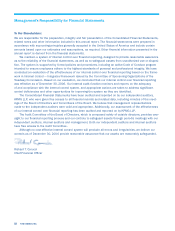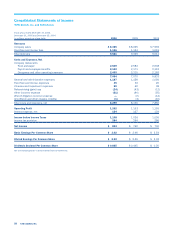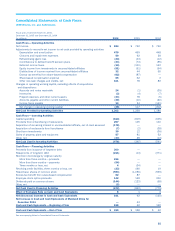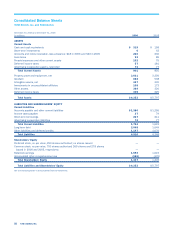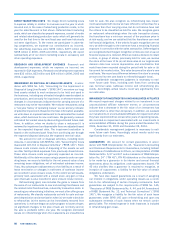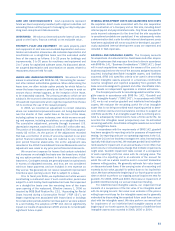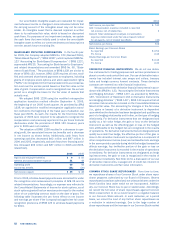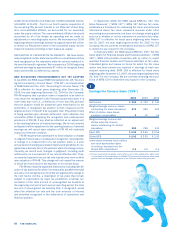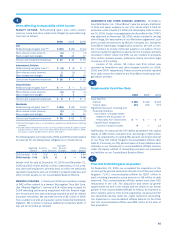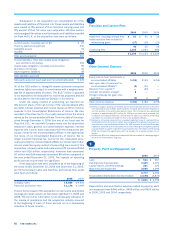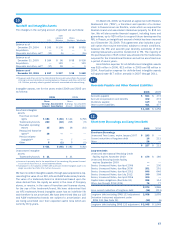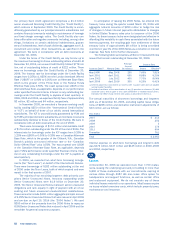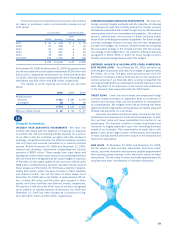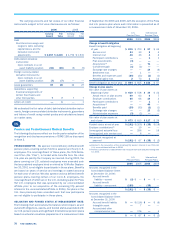Pizza Hut 2006 Annual Report Download - page 57
Download and view the complete annual report
Please find page 57 of the 2006 Pizza Hut annual report below. You can navigate through the pages in the report by either clicking on the pages listed below, or by using the keyword search tool below to find specific information within the annual report.
62 YUM! BRANDS, INC.
Our amortizable intangible assets are evaluated for impair-
ment whenever events or changes in circumstances indicate that
the carrying amount of the intangible asset may not be recov-
erable. An intangible asset that is deemed impaired is written
down to its estimated fair value, which is based on discounted
cash flows. For purposes of our impairment analysis, we update
the cash flows that were initially used to value the amortizable
intangible asset to reflect our current estimates and assumptions
over the asset’s future remaining life.
SHARE-BASED EMPLOYEE COMPENSATION In the fourth quar-
ter 2005, the Company adopted SFAS No. 123 (Revised 2004),
“Share-Based Payment” (“SFAS 123R”), which replaced SFAS No.
123 “Accounting for Stock-Based Compensation” (“SFAS 123”),
superseded APB 25, “Accounting for Stock Issued to Employees”
and related interpretations and amended SFAS No. 95, “State-
ment of Cash Flows.” The provisions of SFAS 123R are similar to
those of SFAS 123, however, SFAS 123R requires all new, modi-
fied and unvested share-based payments to employees, including
grants of employee stock options and stock appreciation rights
(“SARs”), be recognized in the financial statements as compensa-
tion cost over the service period based on their fair value on the
date of grant. Compensation cost is recognized over the service
period on a straight-line basis for the fair value of awards that
actually vest.
We adopted SFAS 123R using the modified retrospective
application transition method effective September 4, 2005,
the beginning of our 2005 fourth quarter. As permitted by SFAS
123R, we applied the modified retrospective application transi-
tion method to the beginning of the fiscal year of adoption (our
fiscal year 2005). As such, the results for the first three fiscal
quarters of 2005 were required to be adjusted to recognize the
compensation cost previously reported in the pro forma footnote
disclosures under the provisions of SFAS 123. However, years
prior to 2005 were not restated.
The adoption of SFAS 123R resulted in a decrease in oper-
ating profit, the associated income tax benefits and a decrease
in net income as shown below. Additionally, cash flows from
operating activities decreased $62 million and $87 million in
2006 and 2005, respectively, and cash flows from financing activi-
ties increased $62 million and $87 million in 2006 and 2005,
respectively.
2006 2005
Payroll and employee benefits $9 $10
General and administrative expense 51 48
Operating profit 60 58
Income tax benefit (21) (20)
Net income impact $39 $38
Prior to 2005, all share-based payments were accounted for under
the recognition and measurement principles of APB 25 and its
related interpretations. Accordingly, no expense was reflected in
the Consolidated Statements of Income for stock options, as all
stock options granted had an exercise price equal to the market
value of our underlying common stock on the date of grant. The
following table illustrates the pro forma effect on net income
and earnings per share if the Company had applied the fair value
recognition provisions of SFAS 123 to all share-based payments
for 2004.
2004
Net Income, as reported $ 740
Add: Compensation expense included in reported
net income, net of related tax 3
Deduct: Total stock-based employee compensation
expense determined under fair value based method
for all awards, net of related tax effects (40)
Net income, pro forma 703
Basic Earnings per Common Share
As reported $ 2.54
Pro forma 2.42
Diluted Earnings per Common Share
As reported $ 2.42
Pro forma 2.30
DERIVATIVE FINANCIAL INSTRUMENTS We do not use deriva-
tive instruments for trading purposes and we have procedures in
place to monitor and control their use. Our use of derivative instru-
ments has included interest rate swaps and collars, treasury
locks and foreign currency forward contracts. These derivative
contracts are entered into with financial institutions.
We account for these derivative financial instruments in accor-
dance with SFAS No. 133, “Accounting for Derivative Instruments
and Hedging Activities” (“SFAS 133”) as amended by SFAS No.
149, “Amendment of Statement 133 on Derivative Instruments
and Hedging Activities” (“SFAS 149”). SFAS 133 requires that all
derivative instruments be recorded on the Consolidated Balance
Sheet at fair value. The accounting for changes in the fair value
(i.e., gains or losses) of a derivative instrument is dependent
upon whether the derivative has been designated and qualifies as
part of a hedging relationship and further, on the type of hedging
relationship. For derivative instruments that are designated and
qualify as a fair value hedge, the gain or loss on the derivative
instrument as well as the offsetting gain or loss on the hedged
item attributable to the hedged risk are recognized in the results
of operations. For derivative instruments that are designated and
qualify as a cash flow hedge, the effective portion of the gain or
loss on the derivative instrument is reported as a component of
other comprehensive income (loss) and reclassified into earnings
in the same period or periods during which the hedged transaction
affects earnings. Any ineffective portion of the gain or loss on
the derivative instrument is recorded in the results of operations
immediately. For derivative instruments not designated as hedg-
ing instruments, the gain or loss is recognized in the results of
operations immediately. See Note 14 for a discussion of our use
of derivative instruments, management of credit risk inherent in
derivative instruments and fair value information.
COMMON STOCK SHARE REPURCHASES From time to time,
we repurchase shares of our Common Stock under share repur-
chase programs authorized by our Board of Directors. Shares
repurchased constitute authorized, but unissued shares under the
North Carolina laws under which we are incorporated. Addition-
ally, our Common Stock has no par or stated value. Accordingly,
we record the full value of share repurchases against Common
Stock except when to do so would result in a negative balance
in our Common Stock account. In such instances, on a period
basis, we record the cost of any further share repurchases as
a reduction in retained earnings. Due to the large number of
share repurchases and the increase in our Common Stock market


